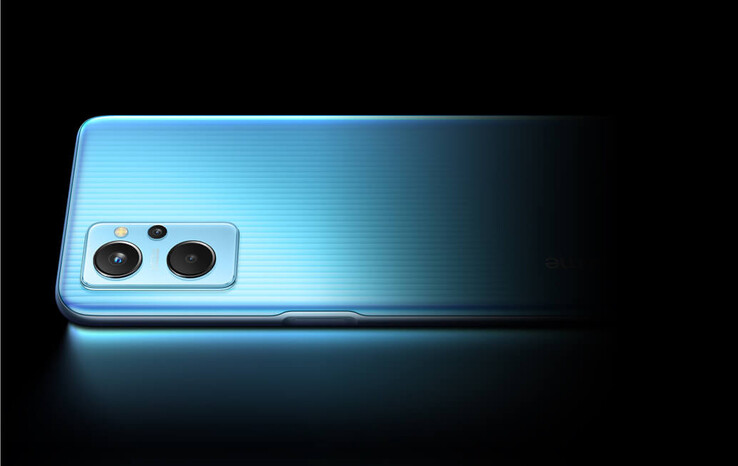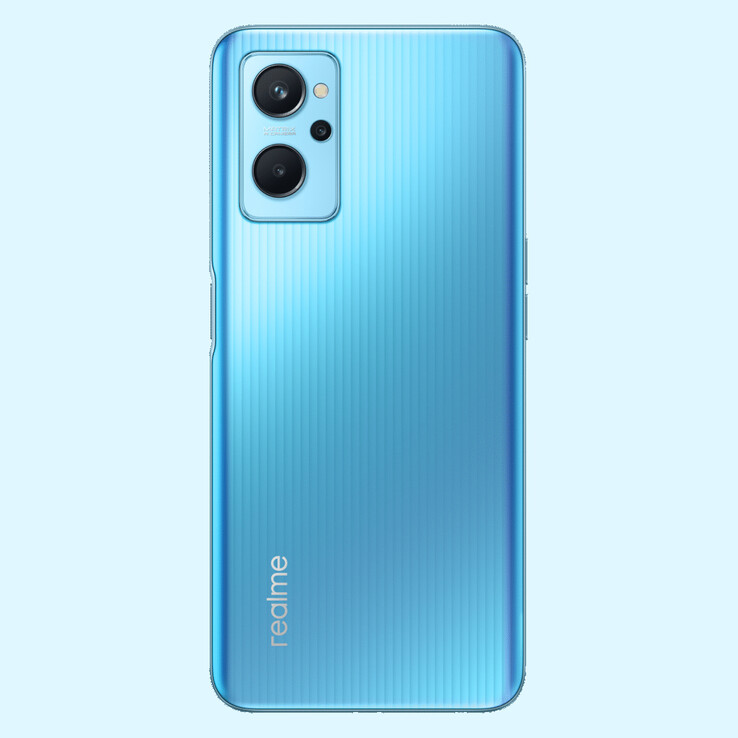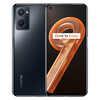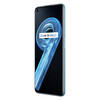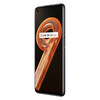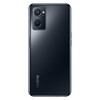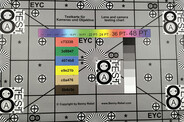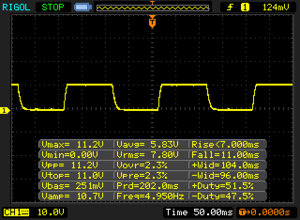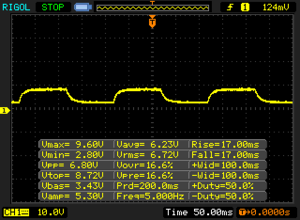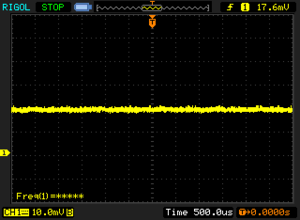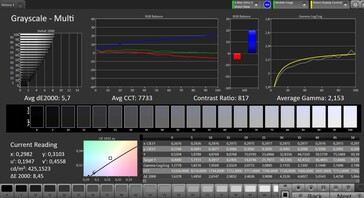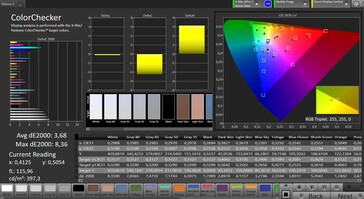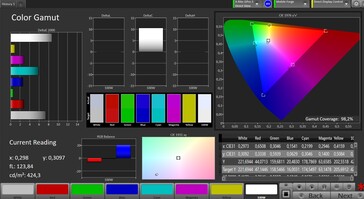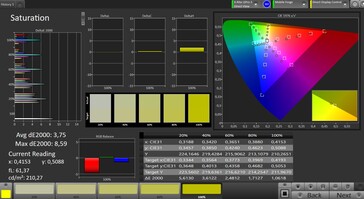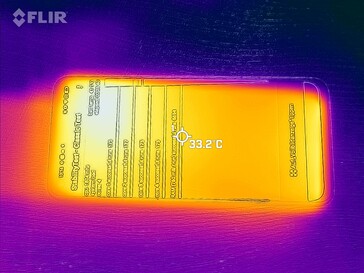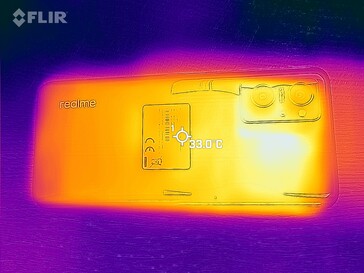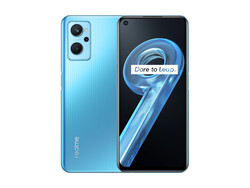realme 9i Smartphone review - Affordable mid-range model with stereo speakers
Possible competitors in comparison
Rating | Date | Model | Weight | Drive | Size | Resolution | Price |
|---|---|---|---|---|---|---|---|
| 78.8 % v7 (old) | 04 / 2022 | Realme 9i SD 680, Adreno 610 | 190 g | 128 GB UFS 2.1 Flash | 6.60" | 2412x1080 | |
| 78.1 % v7 (old) | 08 / 2021 | Samsung Galaxy A22 4G Helio G80, Mali-G52 MP2 | 186 g | 128 GB eMMC Flash | 6.40" | 1600x720 | |
| 80.5 % v7 (old) | 01 / 2022 | Xiaomi Poco M4 Pro 5G Dimensity 810, Mali-G57 MP2 | 195 g | 128 GB UFS 2.2 Flash | 6.60" | 2400x1080 | |
| 80.5 % v7 (old) | 05 / 2021 | Xiaomi Redmi Note 10 SD 678, Adreno 612 | 178.8 g | 128 GB UFS 2.2 Flash | 6.43" | 2400x1080 |
Case and features - Unusual back panel
The realme 9i is currently the cheapest smartphone from realme's 9-series, which represents the mid-range class. For just over 200 Euros you get a smartphone with a plastic back that is decorated with a vertical stripe pattern. Depending on the viewing angle, the back reflects light in such a way, that observers see stripes - an interesting effect that we have not met on any other smartphone.
The color options are light blue or black. Our test device quickly shows spots on the display when pressure is applied to the screen, but they disappear right away. Thus, the stability is average, but the build quality is on a high level.
The manufacturer offers two storage options:
- realme 9i 64 GB mass storage / 4 GB RAM: 220 Euros
- realme 9i 128 GB mass storage / 4 GB RAM: 240 Euros
NFC for mobile payment services is on board, Bluetooth 5.0 and a 3.5 mm audio port are also available. There is also a dedicated microSD slot, so it can be used together with two SIM cards. Tests with our reference microSD card Angelbird AV Pro V60 show, that the microSD reader achieves decent data transfer speeds in both the copy test and the CPDT benchmark.
| SD Card Reader - average JPG Copy Test (av. of 3 runs) | |
| Samsung Galaxy A22 4G (Angelbird V60) | |
| Average of class Smartphone (5.72 - 58.9, n=67, last 2 years) | |
| Realme 9i (Angelbird V60) | |
| Xiaomi Poco M4 Pro 5G (Angelbird AV Pro V60) | |
| Xiaomi Redmi Note 10 (Toshiba Exceria Pro M501) | |
Cross Platform Disk Test (CPDT)
Communication, software and operation - No 5G on the realme phone
In the price range of around 200 Euros, WiFi 5 is the class standard for smartphones. The realme 9i meets this and also offers typical transfer rates of around 300 Mbit/s. However, the speeds fluctuate quite a bit around the actual average rates, so there can also be drops.
The realme 9i does not offer 5G support and there are not many 4G frequencies available, so you might be cut off from mobile Internet when traveling depending on the country. The reception strength is clearly below that of high-end smartphones in our sample test, but it is still usable indoors.
Realme installs Android 11 and the realmeUI 2.0 as the operating system. The security patches are from March 2022 at the time of testing and are thus up to date. Realme does not provide any official information about how long the smartphone will be supported with system and security updates, but since the realme 7 will still get Android 12, at least 2 OS upgrades should be secured.
The 90 Hz screen and the modern processor enable a smooth system operation. The fingerprint sensor is located on the right side of the casing in the slightly recessed standby button and unlocks the device quickly and reliably.
| Networking | |
| iperf3 transmit AX12 | |
| Samsung Galaxy A22 4G | |
| Xiaomi Redmi Note 10 | |
| iperf3 receive AX12 | |
| Samsung Galaxy A22 4G | |
| Xiaomi Redmi Note 10 | |
| iperf3 transmit AXE11000 | |
| Realme 9i | |
| iperf3 receive AXE11000 | |
| Realme 9i | |
Cameras - Weak in low light
The realme 9i has a main camera with 50 megapixels. However, the full resolution can only be used in a special mode. Usually, pictures are recorded with only a quarter of the resolution via pixel binning and thus achieve a higher light intensity. The image sharpness is still decent even with magnification, but large areas like the sky show stripes and color fringes in objects.
The camera obviously struggles in very low light, which is also proven by the pictures from our photo lab, where we can regulate the lighting conditions even better. Videos can be recorded at 1080p and 30 fps, and the autofocus and brightness adjustment work quite quickly and accurately here. The possibility of smooth speed control of the digital zoom is nice, so cool effects can be created.
There is no wide-angle lens, only a macro lens that you can use in a special mode. The third lens includes contains a black-and-white sensor that is used to support the main camera in blur effects.
Image comparison
Choose a scene and navigate within the first image. One click changes the position on touchscreens. One click on the zoomed-in image opens the original in a new window. The first image shows the scaled photograph of the test device.
Main cameraMain cameraLow Light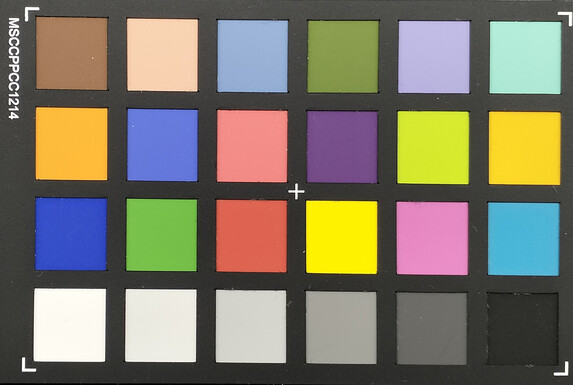

Display - Bright IPS screen in the realme phone
An AMOLED display like in the Galaxy A22 4G or the Redmi Note 10 is not available in the realme 9i. Instead, it has a Full HD IPS display that can convince with an average maximum brightness of over 500 cd/m². It is also nice that the brightness distribution is quite even. It is a 90 Hz display that can dynamically adapt the frame rate to the viewed content. However, this adjustment is not smooth and is going with 5 steps starting at 30 Hz.
The black value of 0.6 cd/m² is rather mediocre, and a clearly visible bluish cast in bright colors also dims the impression of the picture quality. The color deviations are quite high in blue tones, but overall still within limits. We did not measure PWM
| |||||||||||||||||||||||||
Brightness Distribution: 97 %
Center on Battery: 508 cd/m²
Contrast: 847:1 (Black: 0.6 cd/m²)
ΔE ColorChecker Calman: 3.68 | ∀{0.5-29.43 Ø4.78}
ΔE Greyscale Calman: 5.7 | ∀{0.09-98 Ø5}
98.2% sRGB (Calman 2D)
Gamma: 2.153
CCT: 7733 K
| Realme 9i IPS, 2412x1080, 6.6" | Samsung Galaxy A22 4G Super AMOLED, 1600x720, 6.4" | Xiaomi Poco M4 Pro 5G TFT-LCD, 2400x1080, 6.6" | Xiaomi Redmi Note 10 AMOLED, 2400x1080, 6.4" | |
|---|---|---|---|---|
| Response Times | 75% | -70% | 84% | |
| Response Time Grey 50% / Grey 80% * (ms) | 34 ? | 6 ? 82% | 50 ? -47% | 4.8 ? 86% |
| Response Time Black / White * (ms) | 18 ? | 6 ? 67% | 34.8 ? -93% | 3.2 ? 82% |
| PWM Frequency (Hz) | 127.6 | 250 ? | ||
| Screen | -27% | 2% | 37% | |
| Brightness middle (cd/m²) | 508 | 349 -31% | 504 -1% | 695 37% |
| Brightness (cd/m²) | 513 | 352 -31% | 499 -3% | 693 35% |
| Brightness Distribution (%) | 97 | 92 -5% | 91 -6% | 98 1% |
| Black Level * (cd/m²) | 0.6 | 0.72 -20% | ||
| Contrast (:1) | 847 | 700 -17% | ||
| Colorchecker dE 2000 * | 3.68 | 5.87 -60% | 3.3 10% | 2.2 40% |
| Colorchecker dE 2000 max. * | 8.36 | 15.51 -86% | 6 28% | 4.8 43% |
| Greyscale dE 2000 * | 5.7 | 2.7 53% | 4.1 28% | 1.9 67% |
| Gamma | 2.153 102% | 2.07 106% | 2.28 96% | 2.25 98% |
| CCT | 7733 84% | 6970 93% | 7041 92% | 6286 103% |
| Total Average (Program / Settings) | 24% /
-1% | -34% /
-12% | 61% /
49% |
* ... smaller is better
Display Response Times
| ↔ Response Time Black to White | ||
|---|---|---|
| 18 ms ... rise ↗ and fall ↘ combined | ↗ 7 ms rise | |
| ↘ 11 ms fall | ||
| The screen shows good response rates in our tests, but may be too slow for competitive gamers. In comparison, all tested devices range from 0.1 (minimum) to 240 (maximum) ms. » 39 % of all devices are better. This means that the measured response time is better than the average of all tested devices (20.2 ms). | ||
| ↔ Response Time 50% Grey to 80% Grey | ||
| 34 ms ... rise ↗ and fall ↘ combined | ↗ 17 ms rise | |
| ↘ 17 ms fall | ||
| The screen shows slow response rates in our tests and will be unsatisfactory for gamers. In comparison, all tested devices range from 0.165 (minimum) to 636 (maximum) ms. » 45 % of all devices are better. This means that the measured response time is similar to the average of all tested devices (31.6 ms). | ||
Screen Flickering / PWM (Pulse-Width Modulation)
| Screen flickering / PWM not detected | |||
In comparison: 53 % of all tested devices do not use PWM to dim the display. If PWM was detected, an average of 8108 (minimum: 5 - maximum: 343500) Hz was measured. | |||
Performance, emissions and battery life - A real long-runner
The Qualcomm Snapdragon 680 is a fairly new SoC that provides enough performance for everyday use. Despite the modern 6 nm manufacturing process, the processor with its 8 cores is usually only on par with the comparison devices, and the graphics unit also delivers typical performance in its class.
It is nice that realme has installed UFS 2.1 storage, which enables quite fast data transfer in our test device. Users will usually have enough power for smooth navigation through the system in everyday use. It only becomes apparent that the smartphone does not offer as much power as high-end smartphones in more complex apps.
It is pleasing that the warming of the realme phone is kept within limits with a maximum of 40.9 °C, even after 1 hour of high load in our benchmarks.
As a bonus, the realme 9i comes with stereo speakers: the earpiece is used as a second speaker. The sound system can get quite loud but does not reach top rates in terms of clarity. At least the trebles are not overemphasized, so the sound remains relatively pleasant even at high volumes. It gets even better with connected speakers or headphones either via the 3.5 mm audio port or Bluetooth. Many codecs are supported here, including LDAC and aptX HD.
The realme 9i is equipped with a 5,000 mah battery that can be charged with a maximum of 33 watts. A suitable charger is included and needs just over an hour for a full charge when the battery is empty. In our WLAN test, the smartphone achieved a runtime of approximately 17:36 hours, which is a good result in a class comparison and is also sufficient for several days away from a power outlet with reasonably frugal use.
| GFXBench | |
| on screen Aztec Ruins Normal Tier Onscreen (sort by value) | |
| Realme 9i | |
| Samsung Galaxy A22 4G | |
| Xiaomi Poco M4 Pro 5G | |
| Xiaomi Redmi Note 10 | |
| Average Qualcomm Snapdragon 680 4G (4.6 - 17, n=15) | |
| Average of class Smartphone (6.2 - 166, n=209, last 2 years) | |
| 1920x1080 Aztec Ruins Normal Tier Offscreen (sort by value) | |
| Realme 9i | |
| Samsung Galaxy A22 4G | |
| Xiaomi Poco M4 Pro 5G | |
| Xiaomi Redmi Note 10 | |
| Average Qualcomm Snapdragon 680 4G (5.1 - 9.8, n=15) | |
| Average of class Smartphone (3.4 - 367, n=209, last 2 years) | |
| on screen Aztec Ruins High Tier Onscreen (sort by value) | |
| Realme 9i | |
| Samsung Galaxy A22 4G | |
| Xiaomi Poco M4 Pro 5G | |
| Xiaomi Redmi Note 10 | |
| Average Qualcomm Snapdragon 680 4G (2.7 - 11, n=15) | |
| Average of class Smartphone (0.85 - 144, n=210, last 2 years) | |
| 2560x1440 Aztec Ruins High Tier Offscreen (sort by value) | |
| Realme 9i | |
| Samsung Galaxy A22 4G | |
| Xiaomi Poco M4 Pro 5G | |
| Xiaomi Redmi Note 10 | |
| Average Qualcomm Snapdragon 680 4G (1.4 - 3.3, n=15) | |
| Average of class Smartphone (1.2 - 146, n=209, last 2 years) | |
| Realme 9i | Samsung Galaxy A22 4G | Xiaomi Poco M4 Pro 5G | Xiaomi Redmi Note 10 | Average 128 GB UFS 2.1 Flash | Average of class Smartphone | |
|---|---|---|---|---|---|---|
| AndroBench 3-5 | -60% | -7% | -38% | -25% | 124% | |
| Sequential Read 256KB (MB/s) | 976 | 297.7 -69% | 964 -1% | 497.4 -49% | 761 ? -22% | 2228 ? 128% |
| Sequential Write 256KB (MB/s) | 719 | 183 -75% | 471 -34% | 241.5 -66% | 296 ? -59% | 1851 ? 157% |
| Random Read 4KB (MB/s) | 176.8 | 101.2 -43% | 148.8 -16% | 131.5 -26% | 154 ? -13% | 296 ? 67% |
| Random Write 4KB (MB/s) | 137.4 | 66.9 -51% | 171.8 25% | 122.1 -11% | 130.4 ? -5% | 337 ? 145% |
Temperature
(±) The maximum temperature on the upper side is 40.9 °C / 106 F, compared to the average of 35.2 °C / 95 F, ranging from 21.9 to 247 °C for the class Smartphone.
(±) The bottom heats up to a maximum of 40.1 °C / 104 F, compared to the average of 34 °C / 93 F
(+) In idle usage, the average temperature for the upper side is 31.1 °C / 88 F, compared to the device average of 32.9 °C / 91 F.
Speaker
Realme 9i audio analysis
(+) | speakers can play relatively loud (88 dB)
Bass 100 - 315 Hz
(-) | nearly no bass - on average 30.4% lower than median
(±) | linearity of bass is average (9.4% delta to prev. frequency)
Mids 400 - 2000 Hz
(±) | higher mids - on average 7.7% higher than median
(+) | mids are linear (6.9% delta to prev. frequency)
Highs 2 - 16 kHz
(+) | balanced highs - only 3.3% away from median
(+) | highs are linear (4.3% delta to prev. frequency)
Overall 100 - 16.000 Hz
(±) | linearity of overall sound is average (21.4% difference to median)
Compared to same class
» 41% of all tested devices in this class were better, 8% similar, 51% worse
» The best had a delta of 11%, average was 35%, worst was 134%
Compared to all devices tested
» 59% of all tested devices were better, 7% similar, 34% worse
» The best had a delta of 4%, average was 24%, worst was 134%
Xiaomi Redmi Note 10 audio analysis
(+) | speakers can play relatively loud (86.3 dB)
Bass 100 - 315 Hz
(-) | nearly no bass - on average 26.1% lower than median
(±) | linearity of bass is average (12.1% delta to prev. frequency)
Mids 400 - 2000 Hz
(+) | balanced mids - only 3.7% away from median
(+) | mids are linear (5.8% delta to prev. frequency)
Highs 2 - 16 kHz
(±) | higher highs - on average 5.5% higher than median
(+) | highs are linear (5.2% delta to prev. frequency)
Overall 100 - 16.000 Hz
(±) | linearity of overall sound is average (17.6% difference to median)
Compared to same class
» 13% of all tested devices in this class were better, 8% similar, 79% worse
» The best had a delta of 11%, average was 35%, worst was 134%
Compared to all devices tested
» 34% of all tested devices were better, 8% similar, 58% worse
» The best had a delta of 4%, average was 24%, worst was 134%
Battery life
| Realme 9i 5000 mAh | Samsung Galaxy A22 4G 5000 mAh | Xiaomi Poco M4 Pro 5G 5000 mAh | Xiaomi Redmi Note 10 5000 mAh | Average of class Smartphone | |
|---|---|---|---|---|---|
| Battery Runtime | |||||
| WiFi Websurfing (h) | 17.6 | 20.9 19% | 16.1 -9% | 14.8 -16% | 19.3 ? 10% |
Pros
Cons
Verdict - Bright screen and large battery for little money
The inexpensive mid-range phone realme 9i can definitely compete with its rivals, and it comes with a bright screen and fast charging technology. In our tests, it also proved to be more durable than many similarly priced devices and does not get excessively warm.
The power development is adequate for a smooth system operation, but it does not exceed the class standard.
The lack of 5G support could be a downer for buyers, and the display's distinct bluish cast should also be considered before buying. Photographs in low light look quite gloomy, but we like the pictures quite well in normal lighting. It is just a pity that realme does not install a wide-angle camera for more flexibility.
Inexpensive, pretty, and fast: The realme 9i is quite convincing, but has a weakness in low-light photography.
Overall, the realme 9i is worth buying. Especially if you can get it at a good price. The Xiaomi Poco M4 Pro 5G however, can boast of 5G and even more performance. If you would rather have an AMOLED screen, you can take a closer look at the Redmi Note 10.
Price and availability
The realme 9i is available with 64 or 128 GB directly from the manufacturer. But also Cyberport and other big retailers like amazon.de or notebooksbilliger.de have a smartphone on offer.
Realme 9i
- 04/02/2022 v7 (old)
Florian Schmitt




